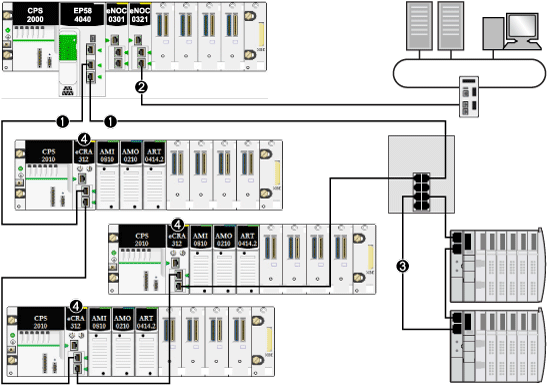A high-capacity daisy chain loop incorporates in the . The following are possible:
Planning a High-Capacity Daisy Chain Loop
An M580 local rack contains a and supports a maxiumum of eight Ethernet communication modules, including BMENOC0301 or BMENOC0311 modules and BMENOS0300 network option switch modules. Only one of these modules can be a BMENOC0321 network option switch module. The number of communication modules with DIO scanning service depends on your
CPU selection.
If you use both RIO and distributed equipment in the , use a
CPU that supports both RIO and DIO scanning, referred to in this guide as a CPU with Ethernet I/O communication service. These are the CPUs with commercial references that end in
40.
NOTE:
-
RIO drops maintain their and cable redundancy in a high-capacity daisy chain loop network. If a communication disruption (for example, a broken wire) occurs on the or any of the RIO sub-rings, the network will recover within 50 ms.
-
To keep the network recovery time within the 50 ms limit, a maximum of 32 devices (including a CPU with Ethernet I/O communication server service in the local rack) are allowed on the main ring.
-
A maximum of 31 RIO drops (each drop containing a BM•CRA312•0 X80 EIO adapter module) are allowed on the RIO network.
-
To diagnose a break in a daisy chain loop, refer to the diagnostics chapter in the BMENOS0300
guide.
Connecting Distributed Equipment to the RIO Network
This BMEP58••40 CPU (with Ethernet I/O scanning service) on a local rack supports an RIO main ring with distributed equipment connected to the RIO network:
1
The M580 CPU is connecected to the main ring.
2
The BMENOC0321 control network module is connected to the control network, creating transparency between the device network and the control network.
3
The DIO sub-ring is connected to the main ring through a dual-ring switch (DRS).
4
RIO drops are connected to the main ring through BM•CRA312•0 (e)X80 EIO adapter modules. 